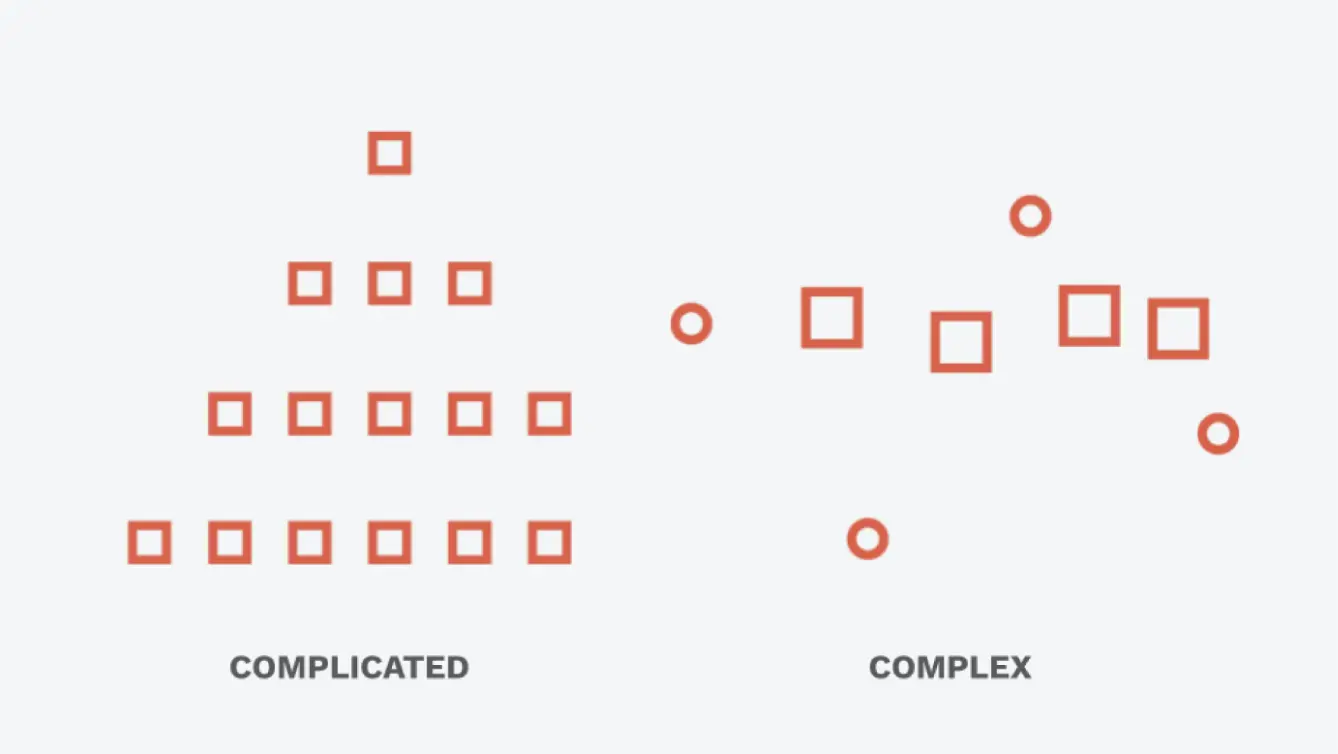Complicated problems consist of elements whose behaviors and interactions are more well‐understood, often linear, and therefore predictable. For example, let's say you want to build a passenger jet. If you have a plan, hire expert designers, gather builders, and have enough money, you'll probably succeed in building a jet. Even though building a jet is neither simple nor cheap, the relationships between all the parts and labor are well understood. When there is a complicated problem to solve, such as how to reduce the cost of making a jet, the best approach is to optimize those predictable relationships. Sourcing the same rotor from a cheaper supplier, standardizing quality measurements, or negotiating for lower labor wages are logical approaches to solving the complicated problem of reducing costs. Great operational leaders focus on building with efficient, measurable, repeatable execution.
This is an advanced version of a model that emerged out of Fredrick Taylor's scientific management in the late nineteenth century. 1 Taylor did “time and motion” studies of workers in factories, creating scientific models that included workers as part of the equation. The promise was that one could develop a scientific equation with a right answer, enabling managers and owners to operate factories in predictable, measurable ways. Eventually known as Taylorism, this approach to measuring production ushered in the assembly‐line system used to manufacture goods in the early twentieth century. Over the next hundred years, it influenced all sorts of work, from retail to software production. As this became more widespread, military leaders, business schools, and management consultants developed operational and leadership models of productivity to accompany Taylor's approach. The command‐control, optimize and execute, hierarchical organizational models derived from the understanding of problems as complicated. There was a right answer, and the most admired leaders had it.
Taylorism produced some obvious fallacies, especially with the rise of professions where people were paid primarily to think, as opposed to assemble. The shift to knowledge work made using complicated methods like time‐and‐motion equations to judge productivity less useful. For example, it's hard to imagine that the effectiveness of the famous 1959 “Think Small” Volkswagen Beetle advertising campaign 2 could have been calculated with a linear productivity equation that measured words per copywriter. Other fields, from management consulting, to design, computer science, and software development, defied previously valid assessments of productivity, quality, or value, based on Taylor's time‐and‐motion models.
 1959 “Think Small” Volkswagen Beetle advertising campaign
1959 “Think Small” Volkswagen Beetle advertising campaign
Source: Bill Bernbach’s iconic ‘Think Small’ Volkswagen Beetle ad. Martin Schilder Groep/Flickr, CC BY‐NC‐SA
Early in my career, I was advised to come early to the office and stay late, not because it would produce better work but because I would be regarded as a highly productive, committed, hard worker. I watched colleagues walk the halls, wearing their “I'm working hard” face, coincidentally timed for their manager to see them as they arrived at the office. Today, part of the debate about working from home versus returning to the office is framed as, “How do I know my employees are working?” This leads to misplaced choices like measuring how long employees are at their computers or in virtual meetings, instead of measuring the outcomes of their work. This is a manifestation of the complicated model of productivity, where there is a linear relationship between time in office and “This is good” work. In contrast, what is now being considered as “the future of work” is that global, hybrid, knowledge work doesn't assume a building – it enables us to think in new ways about defining work with purpose and impact.
Complex problems consist of elements that are distinct from complicated problems. Samuel Arbesman, a complexity scientist, declares, “Complex is a large number of moving parts interacting in multifaceted ways.” 3 The interactions are less well understood, and the relationships are often nonlinear. Because the elements are interacting in multifaceted ways, you can't necessarily predict what the results of those interactions are going to be.
Peter Ho is chairman of the Urban Redevelopment Authority in Singapore. His expertise on complexity informed his country's response to the threat of SARS in 2003, and he wrote:
The natural world is complex. In comparison, an engineering system – be it an airplane or a telecommunications satellite – is merely complicated. 4
A complex system does not necessarily behave in a repeatable and predetermined manner. As a result, not only may a change to one part of a complex system yield unexpected results, but these results may be hidden. Think of the impact on your commute time of an accident just before a merge into a tunnel. Not only is the main route clogged, but so are the side routes and your secret cut‐throughs. Further, impatient drivers might start to take more risks, driving on the shoulders or swerving to jump lanes and causing new accidents. Many of these effects are out of your view, but they have significant impact on whether you arrive on time to your first meeting. Whether it is the complex queuing systems you rely on to get to work on time or the global supply chain, unexpected changes are difficult to plan for because of the sheer number of elements interacting in unpredictable ways.
Twentieth‐century problems were, by and large, understood as complicated. I believe that our most urgent twenty‐first‐century problems are complex ( Figure I.1). The problem is when a leader tries to address a complex problem with an approach designed for a complicated problem ( Figure I.2).

FIGURE I.1 Complicated vs. complex systems: Elements only.
Source: Everett Harper and Josh Franklin, 2021.

FIGURE I.2 Complicated vs. complex systems: Impact of adding one new element on relationships.
Source: Everett Harper and Josh Franklin, 2021.
When we apply complicated problem solving to complex problems, there's bound to be a mismatch. For example, problem solving in a complicated system is often about optimization , where the goal is to fine‐tune a process to reduce wasted time, materials, errors, or friction, while achieving the same outcome. For example, if I want to ensure I get exercise before going to work, I set my alarm, prep my water bottles, and lay out my workout clothes before going to bed. These are steps to optimize my system and reduce the likelihood that I will hit the snooze button. 5
Returning to the example of building a plane, once a builder understands the relationships between the elements, from parts, to suppliers, to builders, then the focus is appropriately on building systems to optimize different factors in construction. The focus on becoming efficient saves millions of dollars, and so very sophisticated systems manage these relationships. The key is the valid, tested knowledge of the interactions between each of the elements in the system.
Читать дальше

 1959 “Think Small” Volkswagen Beetle advertising campaign
1959 “Think Small” Volkswagen Beetle advertising campaign












